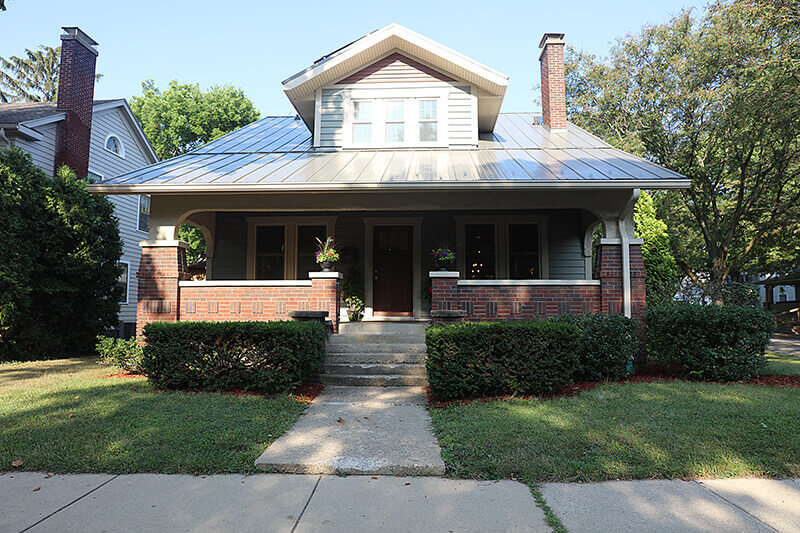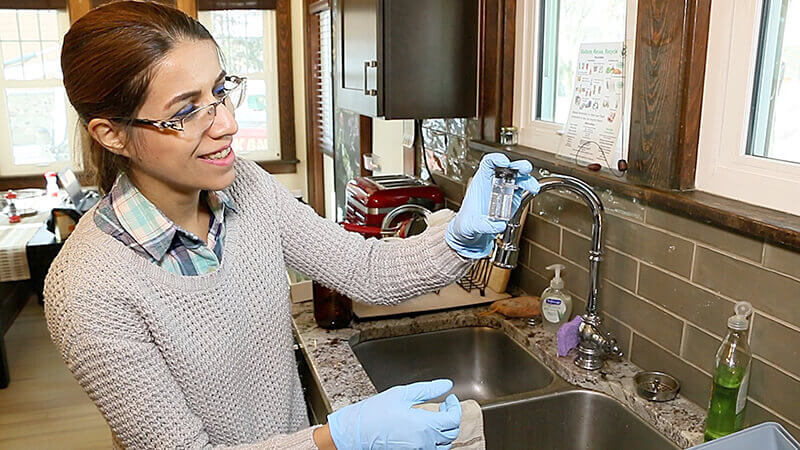February 19, 2020
Study: Your home’s water quality could vary by the room – and the season
WEST LAFAYETTE, Ind. — Is the water in your home actually safe, given that water utility companies in the U.S. aren’t required by law to monitor the water that specifically enters a building at its service line?
A study has found that the water quality of a home can differ in each room and change between seasons, challenging the assumption that the water in a public water system is the same as the water that passes through a building’s plumbing at any time of the year.
“This study reveals that drinking water in the service line water is clearly not the same quality at your faucet,” said Andrew Whelton, a Purdue University associate professor of civil engineering and environmental and ecological engineering. Researchers from Purdue, the University of Memphis and Michigan State University conducted the study, published in the journal Building and Environment.
The study is so far the largest and most intensive investigation of water quality over time and throughout a single house. The researchers collected data 58 times at the house over the course of a year, logging more than 222,000 hours and 2.4 billion records. A YouTube video of the work is available at https://youtu.be/NJKEqJXItX4.
 Findings from a yearlong study conducted at a house-laboratory suggest that a home’s water quality varies spatially and over time. (Photo provided by Whirlpool Corporation)
Download image
Findings from a yearlong study conducted at a house-laboratory suggest that a home’s water quality varies spatially and over time. (Photo provided by Whirlpool Corporation)
Download image
While more studies at this scale are needed before generalizing findings to other American homes, the results are concerning: 10% of the time, disinfectant was not found in the water entering the house studied, meaning that the water was not properly protected from bacteria growth once it entered the home.
There were also increases in water pH inside the house and large fluctuations in organic carbon. Either can indicate drastic changes in drinking water chemistry.
The study took place at a three-bedroom house in West Lafayette, Indiana, that also functions as a living laboratory for developing technologies that would make homes more sustainable. The home, called the Retrofitted Net-zero Energy, Water and Waste (ReNEWW) House, is funded by Whirlpool Corp. and is the first lived-in retrofitted net-zero energy, water and waste home. Whirlpool engineers also were actively involved in the study.
“Environmental sustainability is an essential part of Whirlpool Corp.’s heritage of innovative, efficient products, and our long-term commitment to our communities,” said Ron Voglewede, the company's global sustainability director. “ReNEWW House leverages world class facilities in collaboration with Purdue researchers to accelerate the development of sustainable innovations, which advance our constant pursuit of improving life at home.”
The Environmental Protection Agency (EPA) also supported this study.
Federal and state law does require water utilities to report their drinking water’s chemical quality where it enters a buried water distribution network and at select locations throughout that network. But that water may not be representative of the water quality in a building.
And even when utility companies check for lead and copper at a building faucet, they are not required to check faucets throughout the entire house or between seasons.
“We found that the water chemical quality varied significantly through water fixtures due to water temperature, plumbing fixture and different water uses,” said Maryam Salehi, an assistant professor of civil engineering at the University of Memphis, who was previously a postdoctoral research associate at Purdue.
Spatially, there was no disinfectant exiting the house’s water heater more than 85% of the time. While the team found other chemicals to be higher than others between seasons or throughout the house, most of these levels aren’t harmful according to national guidelines.
The level of lead in the ReNEWW house did, however, exceed the American Academy of Pediatrics recommended exposure limit for children. No children were living in the home.
Some of the house’s lead-free plumbing components also were found to leach lead in a bench-scale test.
These findings call for a closer look at both how often utility companies should monitor lead concentration in a home and if governments should more broadly provide financial support to homeowners for testing their own water quality.
Climate change may also exacerbate seasonal variability in water quality.
“It’s known that warmer temperatures allow microorganisms to persist in source water for longer periods of time. Heavier precipitation can also result in combined sewer overflows in some locations, while droughts affect water quantity and available source water,” said Jade Mitchell, an associate professor of biosystems and agricultural engineering at Michigan State University.
Some of the study’s findings could already have implications for other houses in the U.S., given that the ReNEWW house has a similar square footage and plumbing design compared to the average American home.
 Drinking water at a home’s faucet is not the same quality as the water at a service line, researchers have found. Pictured: Maryam Salehi. (Purdue University photo/Erin Easterling)
Download image
Drinking water at a home’s faucet is not the same quality as the water at a service line, researchers have found. Pictured: Maryam Salehi. (Purdue University photo/Erin Easterling)
Download image
“After water enters a home, it continues to age. Older water is more likely to have contaminants that are problematic. Because the quality of water delivered to a single home can vary significantly, and building plumbing can change the water too, predicting drinking water safety at every building faucet is currently not possible,” Whelton said.
The researchers note that different plumbing materials, a varying number of house occupants and other factors could affect the water quality of a home. These factors warrant future study.
More studies like this one could inform the development of new technology for preventing people from encountering unsafe water in their home.
In the meantime, there are several precautions consumers could take to improve their home’s water quality.
“Choose plumbing designs that minimize the amount of water and time that water sits still. This should help limit microbial growth and lessen the chance that chemicals leaching from the plumbing exceed unacceptable levels. If you have an existing home, flush the faucet before taking a drink to get rid of the old water. Flushing can help bring in new, fresher water from the building entry point,” Whelton said.
This work was supported by an ongoing $2 million grant from the EPA and involves 28 nonprofit, private and government sector organizations. More plumbing safety tips and resources are available on Whelton’s site at plumbingsafety.org.
Writer: Kayla Wiles, 765-494-2432, wiles5@purdue.edu
Source: Andrew Whelton, 765-494-2160, awhelton@purdue.edu
Related News Releases:
Five tips: Refresh your plumbing before and after the holidays to avoid buildup in pipes
Project focuses on reducing pathogen threat in low-flow water systems
Note to Journalists: For a copy of the paper, please contact Kayla Wiles, Purdue News Service, at wiles5@purdue.edu or 765-494-2432. A YouTube video is available at https://www.youtube.com/watch?v=U1dZ2HkrobE&feature=youtu.be. Photos and b-roll of the ReNEWW House and data collection for this study are available in a Google Drive folder at http://bit.ly/plumbing-safety-media. The folder also includes animations explaining how water ages in pipes.
ABSTRACT
An Investigation of Spatial and Temporal Drinking Water Quality Variation in Green Residential Plumbing
Maryam Salehi,1 Tolu Odimayomi,2 Kyungyeon Ra,1 Christian Ley,1 Ryan Julien,3 A. Pouyan Nejadhashemi,3 J. Sebastian Hernandez-Suarez,3 Jade Mitchell,3 Amisha D. Shah,2 Andrew Whelton2
1University of Memphis, Memphis, TN, USA
2Purdue University, West Lafayette, IN, USA
3Michigan State University, East Lansing, MI, USA
DOI: 10.1016/j.buildenv.2019.106566
Drinking water chemical quality can deteriorate after water enters building plumbing. This study aimed to better understand seasonal and spatial water quality differences in a highly monitored net-zero energy residential building. Water flow rate and temperature were monitored for one year at the service line and at every fixture throughout the crosslinked polyethylene plumbing. Discrete water sampling events (58) were conducted at the service line, 1st floor kitchen sink, 2nd floor bathroom sink, the water heater, and 2nd floor shower. More than 2.4 billion online monitoring records were collected for fixture flow and temperature. In-building water stagnation time varied seasonally and across fixtures. Significant spatial and temporal water chemical quality variations were found. Average seasonal variability was found for service line temperature (15–23 °C) for the total chlorine residual (0.4–0.9 mg/L-Cl2), NH3 (<0.01–0.4 mg/L-N), NO3− (0.1–0.8 mg/L-N), and Cu (32–81 μg/L) concentrations. For 10.3% of the discrete water sampling events, service line water did not contain a detectable total chlorine residual. Water pH consistently and significantly increased in the plumbing system from 7.5 to 9.4, and total trihalomethane (TTHM) levels increased up to 89%. The service line total organic carbon level (0.5–0.6 mg/L) was consistent, but much greater in-building variability was found for cold (0.4–61.0 mg/L) and hot water (0.5–4.7 mg/L). Models are needed to predict chemical water quality at the faucet using service line water quality results and plumbing design and operational information. Building water sensor technology innovations are also needed.

